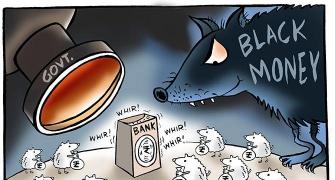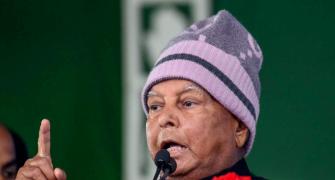'It is common knowledge that cash is anonymous.'
'When demonetisation was implemented, one of the intended objectives was to put identity on the cash holdings in the economy.'
'With the return of Rs 15.28 lakh crore in the formal banking system, the almost entire cash holding of the economy now has an address.'
'It is no more anonymous,' says Arun Jaitley.
Illustrations: Uttam Ghosh/Rediff.com
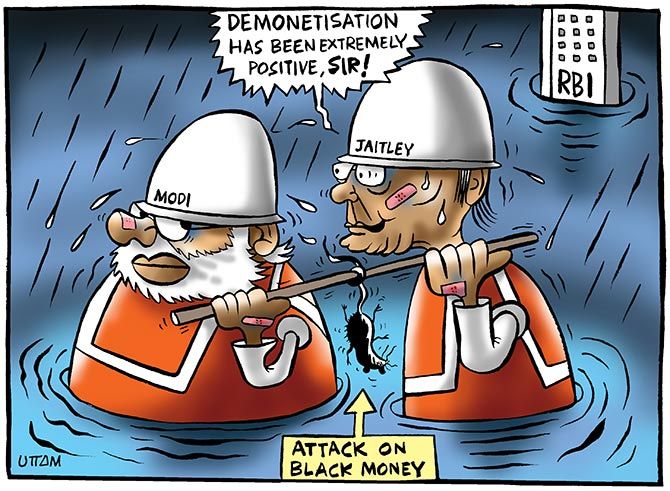
November 8, 2016 would be remembered as a watershed moment in the history of the Indian economy.
This day signifies the resolve of this government to cure the country from the 'dreaded disease of black money'.
We, Indians, were forced to live with this attitude of 'chalta hai' with respect to corruption and black money and the brunt of this attitude was faced particularly by the middle class and lower strata of society.
It was a hidden urge of the larger section of our society for a long period to root out the curse of corruption and black money; and it was this urge which manifested in the verdict of people in May 2014.
Immediately after taking up responsibility in May 2014, this government decided to fulfil the wish of the people in tackling the menace of black money by constituting an SIT on black money.
Our country is aware that how even a direction from the Supreme Court on this issue was ignored by the then government for number of years.
Another example of lack of will to fight against black money was the delay of 28 years in implementation of the Benami Property Act.
This government took decisions and implemented the earlier provisions of law in a well-considered and planned manner over three years to meet the objective of the fight against black money.
These decisions span from setting up the SIT to passing necessary laws for foreign assets to demonetisation and to implementation of the GST.
When the country is participating in 'Anti-Black Money Day', a debate was started whether the entire exercise of demonetisation has served any intended purpose.
This narrative attempts to bring out the positive outcomes of demonetisation in the short-term and medium-term with respect to stated objectives.
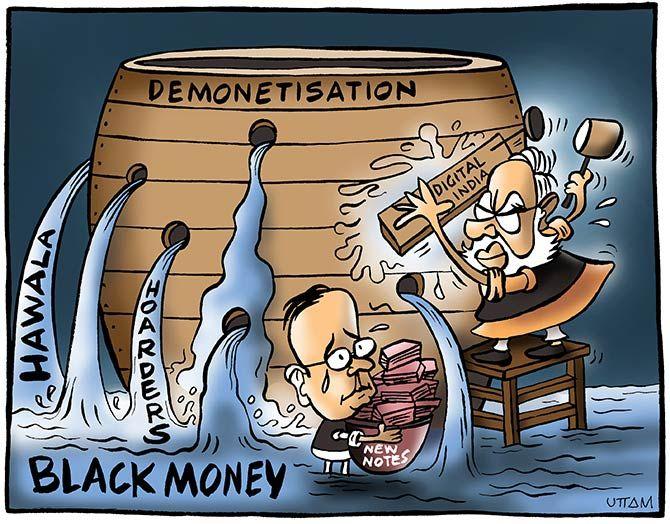
The RBI has reported in its annual accounts that Specified Bank Notes (SBNs) of the estimated value of Rs 15.28 lakh crore have been deposited back as on 30.6.2017.
The outstanding SBNs as on November 8, 2016 were of Rs 15.44 lakh crore value.
The total currency in circulation of all denominations as on November 8, 2016 was Rs 17.77 lakh crore.
One of the important objective of demonetisation was to make India a less cash economy and thereby reduce the flow of black money in the system.
The reduction in currency in circulation from the base scenario reflects that this intended objective has been met.
The published figure of 'currency in circulation' for the half year ending September 2017 is Rs 15.89 lakh crore.
This shows year on year variation of (-) Rs 1.39 lakh crore; whereas year on year variation for the same period during last year was (+) Rs 2.50 lakh crore.
This means that the reduction in currency in circulation is of the order of Rs 3.89 lakh crore.
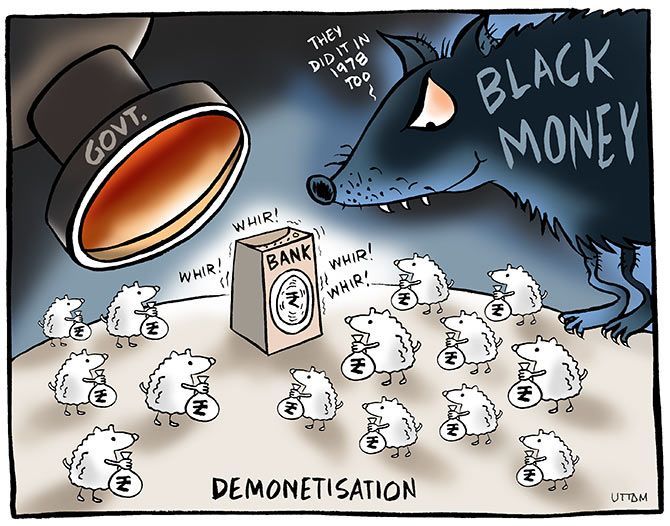
Why should we remove excess currency from the system?
Why should we curtail cash transactions?
It is common knowledge that cash is anonymous. When demonetisation was implemented, one of the intended objectives was to put identity on the cash holdings in the economy.
With the return of Rs 15.28 lakh crore in the formal banking system, the almost entire cash holding of the economy now has an address. It is no more anonymous.
From this inflow, the amount involving suspicious transactions based on various estimates ranges from Rs 1.6 lakh crore to Rs 1.7 lakh crore.
Now it is with the tax administration and other enforcement agencies to use big data analytics and crack down on suspicious transactions.
Steps in this direction have already started. The number of Suspicious Transaction Reports filed by banks during 2016-2017 has gone up from 61,361 in 2015-2016 to 361,214.
The increase during the same period for financial institutions is from 40,333 to 94,836 and for intermediaries registered with SEBI the increase is from 4,579 to 16,953.
Based on big data analytics, cash seizures by the income tax department has more than doubled in 2016-2017 when compared to 2015-2016; during search and seizures by the department Rs 15,497 crore of undisclosed income has been admitted which is 38% higher than the undisclosed amount admitted during 2015-2016; and undisclosed income detected during surveys in 2016-2017 is Rs 13,716 crore which is 41% higher than the detection made in 2015-2016.
Undisclosed income admitted and undisclosed income detected taken together amounts to Rs 29,213 crore which is close to 18% of the amount involved in suspicious transactions.
This process will gain momentum under 'Operation Clean Money' launched on January 31, 2017.
The exercise to remove the anonymity with currency has further yielded results in the form of
- 56 lakh new individual tax payers filing their returns till August 5, 2017 which was the last date for filing return for this category; last year, this number was about 22 lakh.
- Self-Assessment Tax (voluntary payment by tax payers at the time of filing returns) paid by non-corporate tax payers increasing by 34.25% during April 1 to August 5 in 2017 when compared to the same period in 2016.
- With increase in the tax base and bringing back undisclosed income into the formal economy, the amount of advance tax paid by non-corporate tax payers during the current year has also increased by about 42% during April 1 to August 5.
After issuance of statutory notices to these companies and following due process under the law, 2.24 lakh companies have been de-registered from the books of Registrar of Companies.
Further actions was taken under the law to stop the operation of bank accounts of these struck off companies.
Actions are also being taken for freezing their bank accounts and debarring their directors from being on the board of any company.
In the initial analysis of bank accounts of such companies following information has come out which are worth mentioning:
- Of 2.97 lakh struck off companies, information pertaining to 28,088 companies involving 49,910 bank accounts show that these companies have deposited and withdrawn Rs.10,200 crore from November 9. 2016 till the date of strike off from the RoC.
- Many of these companies are found to have more than 100 bank accounts -- one company even reaching a figure of 2,134 accounts.
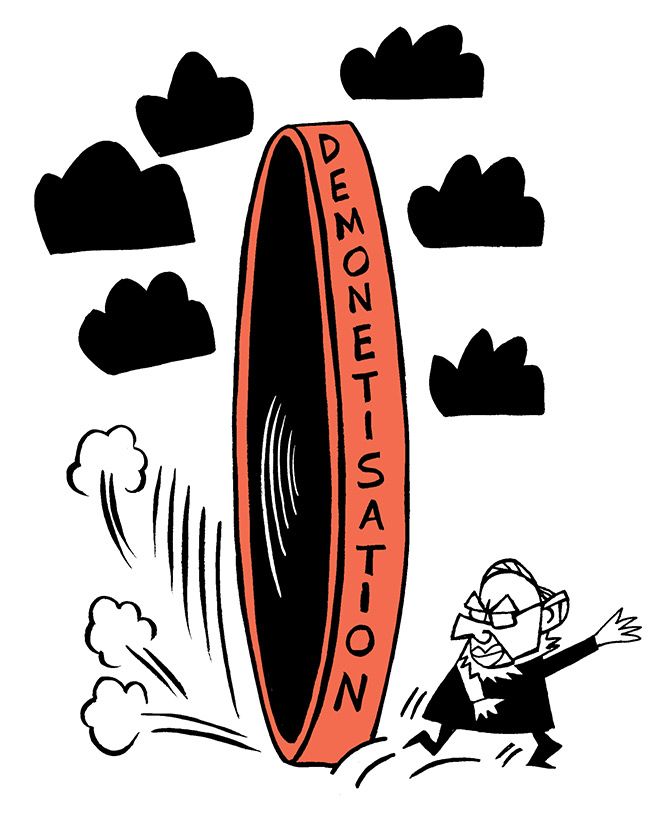
Simultaneously, the income tax department has taken action against more than 1,150 shell companies which were used as conduits by over 22,000 beneficiaries to launder more than Rs 13,300 crore.
Post demonetisation, SEBI has introduced a Graded Surveillance Measure in stock exchanges. This measure has been introduced in over 800 securities by the exchanges.
Inactive and suspended companies many a time are used as harbours of manipulative minds.
In order to ensure that such suspicious companies do not languish in the exchanges, over 450 such companies have been delisted and demat accounts of their promoters have been frozen; they have also been barred to be directors of listed companies.
Around 800 companies listed on erstwhile regional exchanges are not traceable and a process has been initiated to declare them as vanishing companies.
Demonetisation appears to have led to an acceleration in the financialisation of savings.
In parallel, there is a shift towards greater formalisation of the economy in the near term aided by the introduction of GS). Some of the parameters indicating such shift are given below:
- The corporate bond market has started reaping the benefits of additional financial savings and transmission of interest rate reduction. The corporate bond market issuance grew to Rs 1.78 lakh crore in 2016-2017, the year on year increase was Rs 78,000 crore.
- With other sources of issuance in the capital market the incremental variation is almost Rs 2 lakh crore in 2016-2017 while that was Rs 1 lakh crore in 2015-2016.
- This trend is further substantiated by the surge in the primary market raising through public and rights issues. There were 87 issues of public and rights for raising equity involving amount of Rs 24,054 crore during FY 2015-2016; in the first six months of 2017-2018 itself there are 99 such issues amounting to Rs 28,319 crore.
- Net inflow into mutual funds during 2016-2017 increased by 155% during 2016-2017 over 2015-2016 reaching Rs 3.43 lakh crore; Net inflows in mutual funds during November 2016 to June 2017 was about Rs 1.7 lakh crore as against Rs 9,160 crore during the same period in the year before;
- Premia collected by life insurance companies more than doubled in November 2016; the cumulative collections during November 2016 to January 2017 increased by 46 per cent over the same period of the previous year.
- The premium collections witnessed 21% growth for year ending September 2017 over the corresponding period of previous year.
With a shift to a less cash economy, India has taken a big leap in digital payment during 2016-20 17. Some of the trends are given below:
- 110 crore transactions, valued at around Rs 3.3 lakh crore and another 240 crore transactions valued at Rs 3.3 lakh crore were carried out through credit cards and debit cards, respectively.
- The value of transactions for debit and credit card was Rs 1.6 lakh crore and Rs.2.4 lakh crore respectively during 2015-2016.
- The total value of transaction with Pre-Paid instruments have increased from Rs 48,800 crore in 2015-2016 to Rs 83,800 crore in 2016-2017.
- Total volume of transactions through PPIs have increased from about 75 crore to 196 crore.
- During 2016-2017, National Electronic Funds Transfer handled 160 crore transactions valued at Rs 120 lakh crore, up from around 130 crore transactions for Rs 83 lakh crore in the previous year.
With higher level of formalisation, it has brought out related benefits to workers who were denied social security benefits in the form of EPF contribution, subscription to ESIC facilities and payments of wages in their bank accounts.
Large increase in opening of bank accounts for workers, enrolment in EPF and ESIC are added benefits of demonetisation.
More than 1 crore workers were added to EPF and ESIC system post-demonetisation which was almost 30% of existing beneficiaries.
Bank accounts were opened for about 50 lakh workers to get their wages credited in their accounts. Necessary amendment in Payment of Wages Act was done to facilitate this.
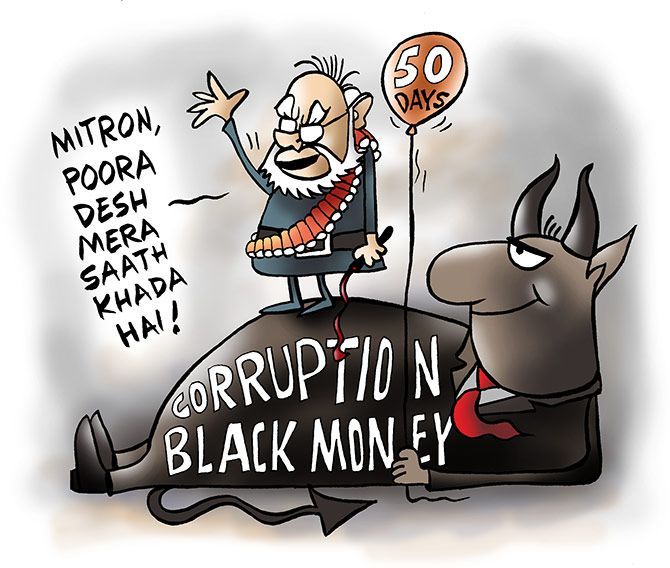
The reduction in incidences of stone pelting, protests in J&K and Naxal activities in LWE affected districts are also attributed to the impact of demonetisation as these miscreants have run out of cash.
Their access to Fake Indian Currency Note was also restricted. During 2016-2017, the detection of FICN for Rs 1,000 denomination increased from 1.43 lakh pieces to 2.56 lakh pieces.
At the Reserve Bank's currency verification and processing system, during 2015-2016, there were 2.4 pieces of FICNs of Rs 500 denomination and 5.8 pieces of FICNs of Rs 1,000 denomination for every million pieces notes processed which rose to 5.5 pieces and 12.4 pieces respectively, during the post-demonetisation period.
This shows almost doubling of such detection.
In an overall analysis, it would not be wrong to say that country has moved on to a much cleaner, transparent and honest financial system.
Benefits of these may not yet be visible to some people. The next generation will view the post November 2016 national economic development with a great sense of pride as it has provided them a fair and honest system to live in.
Arun Jaitley is the finance minister of India.
DON'T MISS the interviews in the RELATED LINKS alongside.


